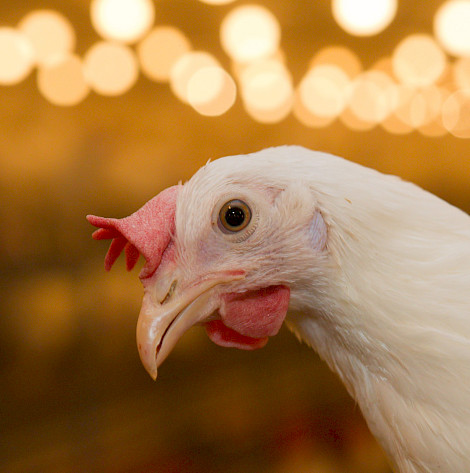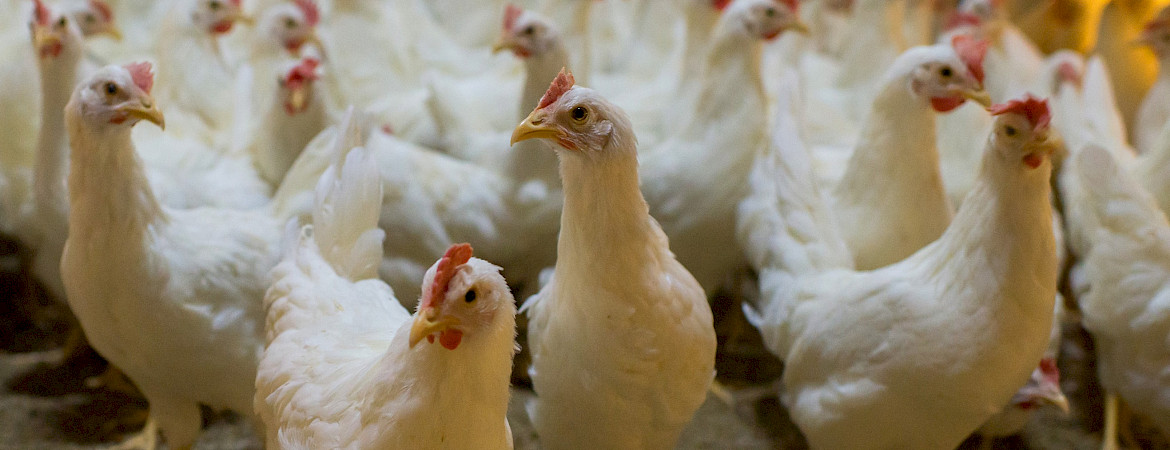

Eggs are produced on about 220 farms in Finland. The number of chickens is about 4 million chickens. In 2024, approximately 79 million kilograms of eggs were produced, and approximately 65.3 million kilograms were consumed. The use of Finnish eggs increased in 2024. Currently, the annual consumption is about 11.7 kilos, or about 198 eggs per person per year.
Egg farms are mainly located in western Finland. The average number of chickens is about 20,000 layers/farm. Hybrids produced by three different chicken breeds are in use in Finland. Laying hens have been bred to produce eggs.
The chickens are raised in hatcheries and transferred to henhouses before the start of laying at around 14-16 weeks of age.
In egg production, mainly light chicken breeds are used. Laying hens usually weigh 1.5 - 2 kg and roosters about a kilo more. Big production henhouses use hybrids produced by international chicken breeding companies.
Hybrids are standardized crossbreeds, produced by systematic breeding. Brown hybrids lay brown eggs and white hybrids lay white eggs.
More than 90% of laying hens are white hybrids.
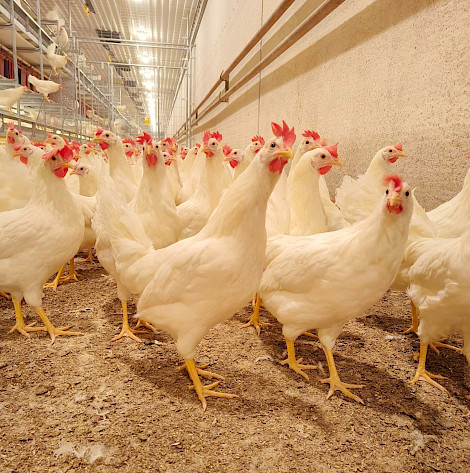
The young chickens are transferred to the henhouses at around 14-16 weeks of age.
Hens start laying eggs at the age of 18–19 weeks, and their egg-laying season lasts a good year. Hens lay more than 20 kilos of eggs a year, more than 330 eggs, i.e. one egg almost every day.
Young hens lay the best eggs. As age increases, egg-laying decreases, the size of eggs increases and the quality of the shell deteriorates.
Once the egg is laid, its quality cannot be improved. Egg quality can be influenced by breeding and feeding before laying. Breeding can affect the production characteristics of the chicken and the quality of the egg, such as the strength of the shell and the firmness of the egg white. Chicken nutrition affects egg quality and supports the hen's well-being throughout the production season. Feed can also influence the egg's nutrient content and cooking properties.
The eggs laid in the henhouses are collected in collection cells. Eggs are collected from the henhouse at least once a day and transferred to a cool egg room. Cells are packed in rolls, which are picked up by the packaging company's collection truck.
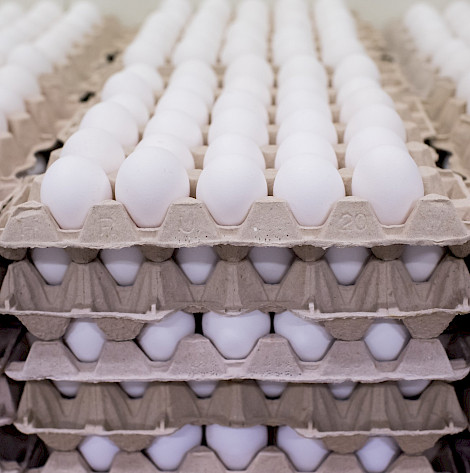
There are about 59 egg packing plants in Finland. Of the packing houses, 6 are large central packing houses and the rest are small packing houses. Farm packing plants where the eggs are packed in the farm's own packing plant, which are subject to the same quality and weight classification regulations as large packing plants.
In the packing house, the eggs are inspected using a transillumination device, graded by quality and weight, stamped and packed.
The egg yolk and white, as well as the size of the egg's air space, are checked in the through-illumination. The egg is disqualified if it has a large or moving air space, blood spots or streaks, or is old and spoiled.
In the quality classification, the shell of the egg is checked. Broken and dirty eggs are rejected. Eggs that have passed the inspection are classified as A or B class.
Class A eggs are fresh, intact and clean eggs sold in stores. Class B eggs are deformed and cracked, but are suitable for use in the egg industry.
After quality control, the eggs are stamped. The stamp indicates the method of production, the country and state of production. Some packing houses put their own stamp on the eggs, which shows the production batch and the packing house.
Class A eggs are weighed and classified according to weight into four classes XL, L, M and S.
Only quality and weight classified eggs may be sold. Exceptions are producers in the area of Lapland, Oulu's former North Karelia and Kuopio counties in the province of Åland, and those who are allowed to sell the eggs they produce unclassified directly to a local retail store up to 30,000 kg.
Finally, the eggs are packed in cells and delivered to stores.
Chickens eat about two kilograms of feed per kilogram of eggs laid. The feed eaten by the chickens is mostly domestic grain: barley, wheat and oats. Soy or domestic broad beans or peas are used as the protein raw material of the feed. When feeding organic chickens, small amounts of fishmeal have been used as one protein source, because fishmeal contains essential amino acids for chickens, such as methionine. Finnish eggs are examided regurlarly, since fishmeal may contain PFAS compounds, the amounts of fishmeal have been reduced or its use has been completely stopped in feeding organic chickens in December 2022.
The feeding of the chickens is modified according to the laying stage and age of the chickens. At the beginning of laying, the feed contains more protein and energy. In the middle stages of the laying season, the amount of protein is reduced and calcium is added, so that the quality of the egg shell remains good until the end of the laying season.
When feeding chickens, you can use complete feed, which is a ready mixture of nutrients necessary for chickens. The most common form of feeding on Finnish chicken farms is a concentrate-grain mixture made on the farms.Grain, lime, vegetable oil and, for example, peas are added to the concentrate in accordance with the feeding recommendation.
Industrial chicken feed in Finland is produced by Agrox, Hankkija and Rehux.
In 2024. Production in Finland was divided as follows:
Enriched cage 20%
Floor/free-run/cage-free 69%
Free range 4%
Organic 7%
(Kantar Agri oy)
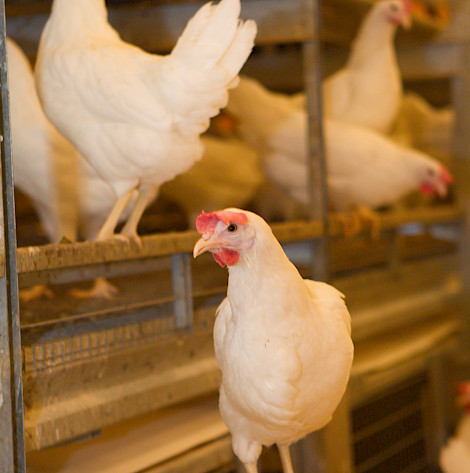
Finland is one of the best in the world in terms of poultry health. Finland's strategy is based on managing disease risks and supporting animal welfare and thus immunity. Prevention is the cheapest and most effective way to manage disease risks. Methods such as single-stocking, intermittent cleaning and strong biosecurity limit the number of pathogens and aim to prevent pathogens such as salmonella from entering the farm. The right conditions, feeding and care give the bird the opportunity to improve and maintain sufficient immunity, allowing it to withstand disease pressure. In managing disease risks, monitoring and supervision ensure a quick and correct response in the event of an exception. Action plans are in place for exception situations.
Vaccination is an effective way to prevent some poultry diseases and Finnish chickens follow the national vaccination recommendation. Viral diseases of poultry that can be prevented by vaccination are Marek's disease, infectious encephalomyelitis, infectious bronchitis, Gumboro disease and blue wing disease. The use of antibiotics in egg production is rare and minimal. Antibiotics are only used on the basis of a diagnosis determined by research and on the advice of a veterinarian when it is necessary for the health and well-being of the birds.
The production chain of eggs is transparent and, if necessary, the egg can be traced from the store through the packing plant to the farm where the egg was laid. Finnish eggs are safe and can be eaten without worry, even raw. Domestic eggs do not contain salmonella, which is very exceptional compared to other countries.
Product safety is ensured at every stage of the production chain.
In Finland, the entire poultry chain has worked for decades to keep salmonella out of poultry production, and for example, domestic eggs have not caused epidemics since 1995. Product recalls due to suspected salmonella are rare and, when they occur, are an indication of a successful and effective control program.
The purpose of salmonella surveillance in poultry is to prevent the spread of salmonella infections to humans through chickens, broilers and turkeys and the food products derived from them, and to keep the incidence of salmonella infections in production animal flocks to a maximum of one percent annually.
Most human infections have been contracted from outside the Nordic countries. In order to maintain our good situation even when operating in the EU internal market, the membership negotiations allowed us to require that food and animal products imported into Finland be tested for salmonella. However, this requires comprehensive salmonella surveillance in Finland.
The program monitors cattle, pigs, poultry, and the meat and eggs obtained from them. The poultry program targets chickens, broilers, and turkeys at the farm level throughout the production chain, from grandparents to the production generation. Eggs may only be delivered to egg packing plants from farms within the scope of the surveillance program, and similarly, animals that have been monitored and tested for salmonella may only be delivered to slaughterhouses. Surveillance also applies to farms that sell poultry products directly to consumers. Slaughterhouses, meat processing plants, and feed manufacturing have their own surveillance programs.
